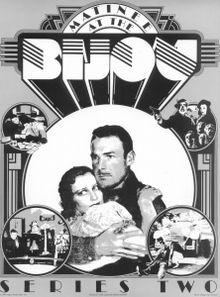- Matinee at the Bijou
-
Matinee at the Bijou was a television series that premiered nationally on PBS in 1980. It recreated the American moviegoing experiences of the 1930s and '40s, with trailers, a cartoon, one or more selected short subjects, a cliff-hanging serial chapter “to be continued,” and a tightly edited feature presentation. The 90-minute series ran for five consecutive first-run seasons, each consisting of 16 episodes, and continued on PBS for three subsequent years in reruns. The series was an independent production from Bijou Productions, Inc., of Medford, Oregon.
Contents
Overview
Going to the movies prior to 1960, and especially prior to the advent of television, could last for several hours, and include many short films along with a single or double feature presentation. Matinee at the Bijou faithfully recreated, albeit on a PBS budget, those all-afternoon or -evening experiences for home audiences.
With Matinee at the Bijou, PBS, known for presenting highbrow, how-to and educational content, gave America a weekly dose of cinematic entertainment for eight years, and the series went on to become a pop culture phenomenon on television and college campuses. Key in producing the show was the creative utilization of public domain content, as the cost of licensing content from the major studios was prohibitive.
The use of public domain content applied to the short subjects and serials, as well as the feature films. Betty Boop was the official Matinee at the Bijou mascot, and many Betty Boop cartoons were featured on the show, along with many other famous cartoon characters.
The theme music played during the opening credits was titled “At the Bijou,” and was performed by crooner Rudy Vallee and written by songwriter/composer Rich Mendoza.
In 1995, an international television distributor, TV Matters, Inc., bought the broadcast rights to the series, and with the help of the series’ producers undertook a makeover updating the opening sequences and retaining only the best film elements from the original 80 episodes. A total of 52 remastered episodes were re-released to many PBS affiliates and also marketed overseas.
Scheduling
Matinee at the Bijou was considered a “fringe-time” series, and episodes were fed to PBS member stations for scheduling any way they chose. Most stations ran the series on weekend mornings or afternoons. Several PBS affiliates, such as KCET in Los Angeles, chose to “strip” Matinee at the Bijou for daily afternoon or morning broadcasts. One West Coast affiliate found ratings success running the series on Saturday nights at 10:00pm, as a lead-in to Saturday Night Live audiences. National Nielsen ratings for the first-run episodes were mostly in the 4.0 to 5-7 ranges, reported as unprecedented for a non-prime time PBS fringe-time series.
Hosts and Producers
For the first three seasons, Matinee at the Bijou was hosted by actor Scott DeVenney. In 1983 the opening format was changed, the host was dropped, and a Sneak Previews-style opening was used, in order to reduce the amount of editing required to fit the content into the 90-minute slot.
Bob Campbell and John Galbraith, series co-creators and producers, presented their concept to PBS in 1979, were given a green light, and Matinee at the Bijou had its national premiere the following year. Galbraith left the series, along with host Scott DeVenney, in 1982, and producer Campbell continued on as executive producer and producer of the following two seasons and the re-release ten years later.
Funders
In 1980, when Matinee at the Bijou was first licensed by PBS, national programs were voted on and chosen by PBS affiliate program managers, rather than national program chiefs. The stations effectively voted their available program dollars in a series of voting “preference rounds.” The Matinee series made the cut for five consecutive seasons, but was not picked up in 1985 due to diminishing programming dollars and the need to spend what was available on core series like Nova, Mystery and Masterpiece Theater. The Dick Cavett Show, another very popular series but one “not critical to the PBS core mission,” had been eliminated the year before.
External links
Categories:- PBS network shows
- 1980s American television series
- 1980 television series debuts
- 1985 television series endings
- Motion picture television series
- Television series produced in Oregon
Wikimedia Foundation. 2010.


